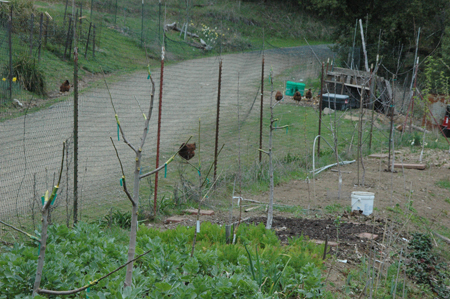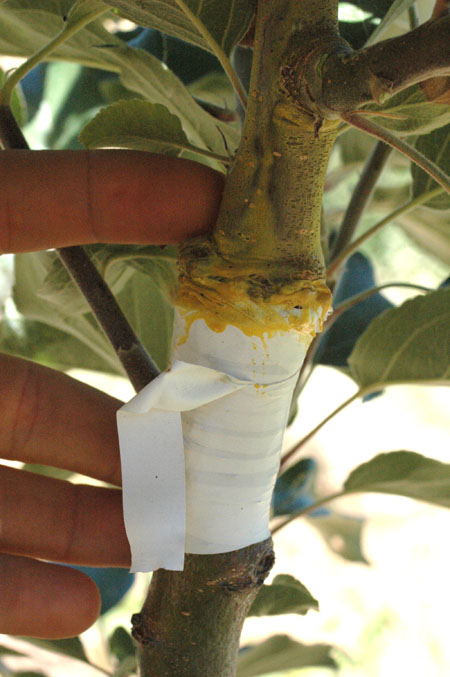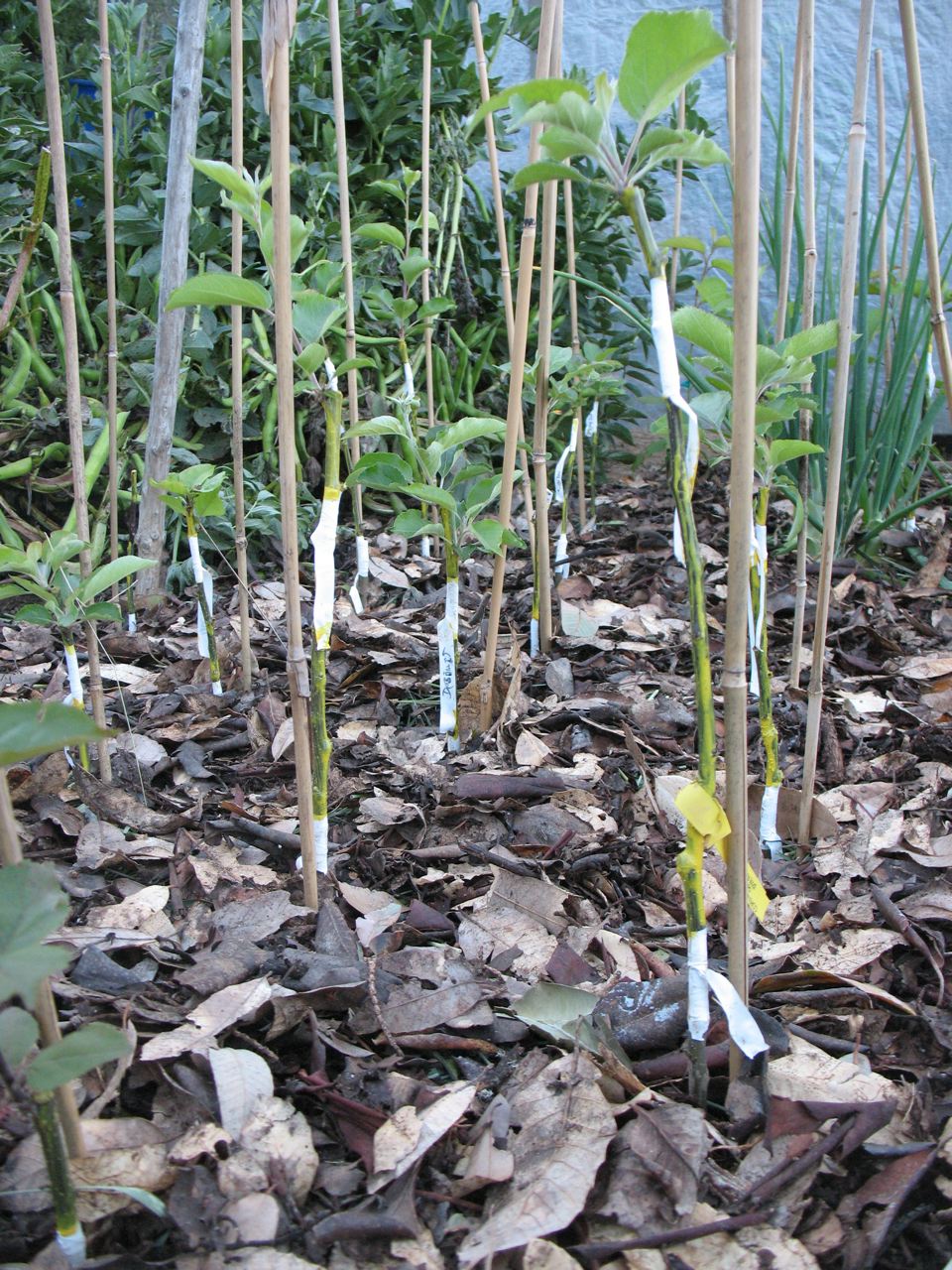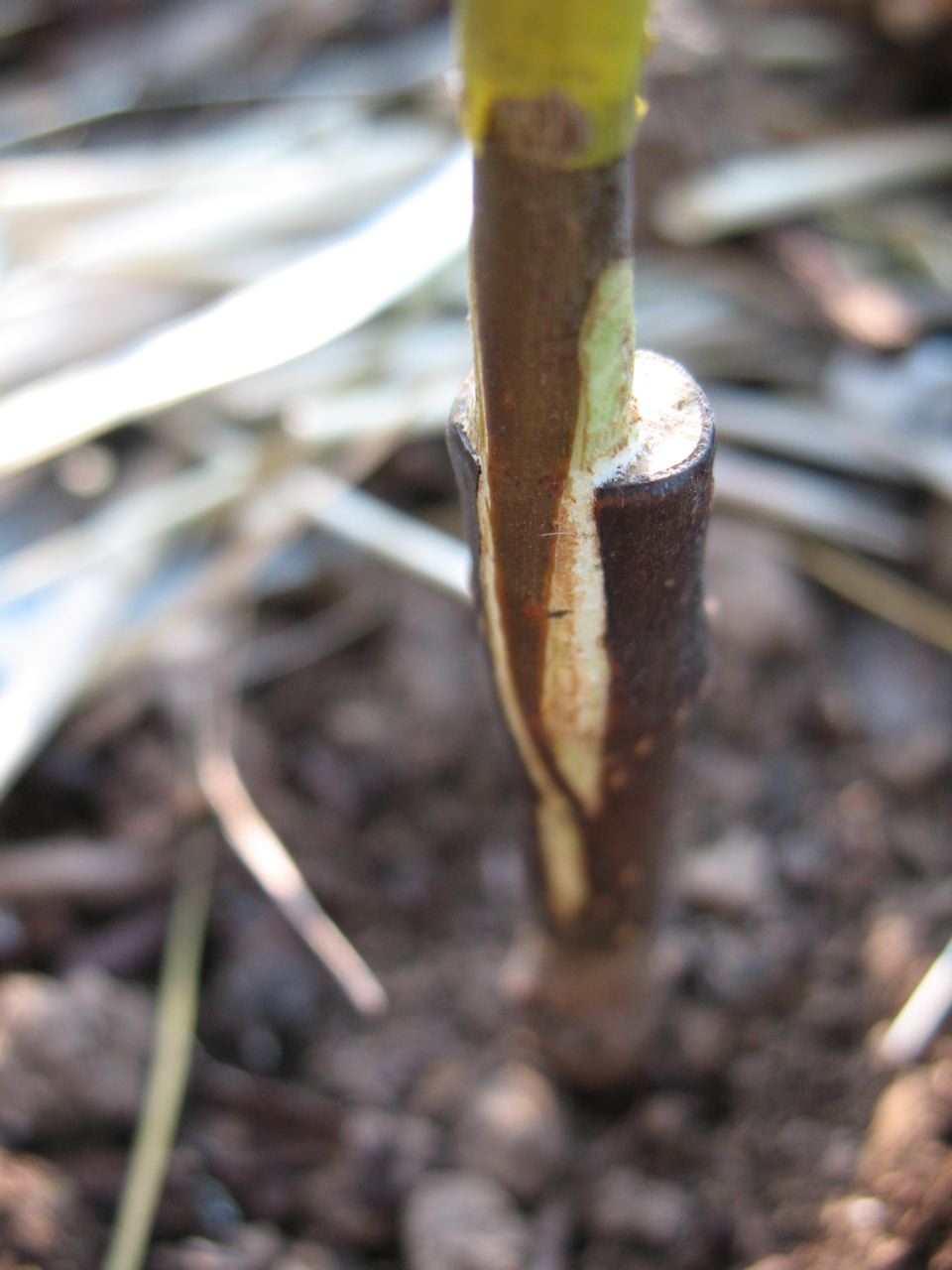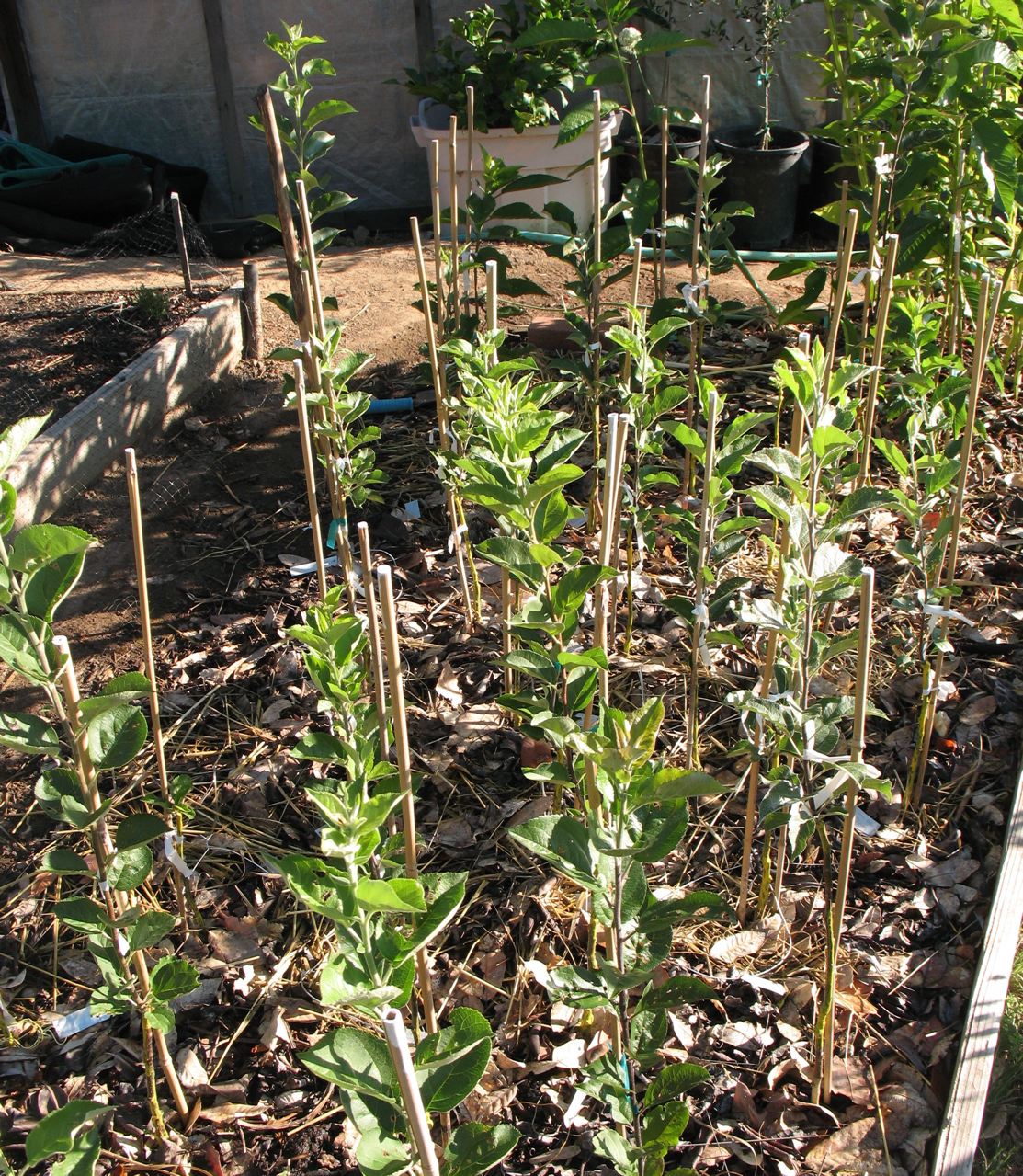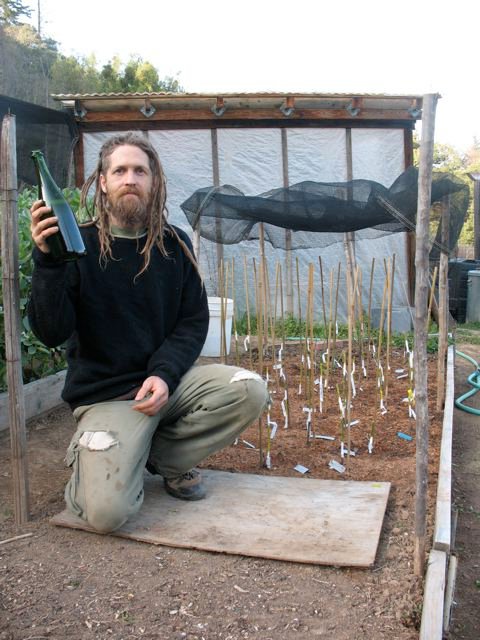It’s been 4 years since I grafted my first interstem apples. They were in the nursery for a year, and have been in the ground in permanent locations for 3 years. This is an update on my experience and thoughts so far. (Read the original post here)
A couple paragraphs for those who aren’t familiar with interstem trees: An interstem (a.k.a. double worked, archaic) tree is one that has an extra stem grafted between the rootstock and the upper portion of the tree. Sometimes the interstem (the stem between the roots and the tree) is there for the sake of compatibility and can be used when the fruit variety is not genetically compatible with the rootstock, but the interstem is compatible with both the top and the rootstock.... think of a kidney transplant, the donor and recipient have to be compatible or the graft will be rejected. Often though, and in my case, the technique is used to dwarf a tree. One problem with dwarf rootstocks is that they are weak. Sure they are small, which is what we want, but so are the roots. Interstem grafting allows us to select a large vigorous rootstock, that would normally grow a large vigorous tree, for the roots and a weak interstem to dwarf the tree... small tree big roots. That means, no staking of the tree, which would be required for a weak dwarfing stock. They also need less water.
Drought Tolerance: My primary motivation for grafting interstem trees has been drought tolerance combined with dwarfing, a pairing which I don't know of any other means of attaining. I’ve had a few of the trees get a little crispy in the end of summer, but over all, I think they are performing much better as m111 / bud 9 interstems than they would on any stand alone dwarfing stock. I do water them occasionally, but not a lot. I probably should ideally water a little more, but I want them to grow up tough and self sufficient, not expecting a drink whenever they want one... tough love. There is a second row of interstem trees that I will probably move, or just remove, which are not cared for nearly as well as the main row along the driveway. Most of these outliers have survived and, although they are not doing great, I doubt many would have survived the droughty conditions they are growing in if they were on a straight dwarfing stock like MM109 or bud 9. I probably won't water any of the interstems this season since my spring is lower than it's ever been at this time.Understory: The original vision for the main row of interstem trees was to establish an understory of flowering bulbs. The trees are along about 100 feet of the driveway as you drive into the main area, and I had envisioned masses of narcissus in the spring that I could hopefully sell some of at the farmer's market. I have an ongoing experiment using flowering bulbs to create fruit tree understories... specifically, plants that grow only in the winter and die back early in the summer leaving a mulch of dead leaves on the soil surface to prevent evaporation. I call this a dying mulch, but it’s more like a living/dying mulch. This plan was hatched specifically to deal with our seasonally dry climate which has virtually no summer rain. Two of the intertstem trees are now planted to Hybrid Amaryllis on 12 inch centers, but it will be some years before I really know how well that system works. Amaryllis is not as spectacular as narcissus and blooms in the late summer, but it is the plant that seems to be performing best in my trials and it’s probably more marketable as a cut flower than narcissus anyhow. I may plant every other tree for now. Having half of the trees as control subjects should show over time whether or not it works.
Root anchorage: The superior root anchorage has proved to be very nice. I’ve barely staked the trees and only to keep them growing straight, not because the roots weren't adequate. Trees this size (8’ x 8’ is the target size) normally require staking because the small and sparse roots simply don’t hold the tree up. Precocity: Interstem trees are precocious, most of mine bore some fruit the second year in the ground. That is a whole lot faster than when using your average M111 or larger rootstocks. Precocity is a great advantage. The trees grow fast to size, but start bearing early and then quit growing for the most part. Most would be nearly the size I want them already, if I hadn’t changed my mind and grafted most of them over to different varieties after the first year. The fruit quality seems good so far, and I think with careful thinning, it would be easy to grow jumbo sized fruits if that matters to you.
Size: One reason I got into this system is because I harvested some dwarfed apple trees and was so excited that I didn’t need a ladder! No ladders for pruning or picking. That’s pretty great. If you’re around 50 or over, no ladders and early bearing should be lookin’ pretty good! No one needs to fall off ladders, but for seniors, it's a big deal to break a hip, and coordination typically declines with age. It’s pretty nice to have a tree where I can reach almost everything. I might need to stand on a box once in a while, but not a ladder. I don’t mind working on ladders too much, but moving them around gets old pretty fast. Not that I would ever advocate planting only dwarfs. Standard trees live longer making them a great legacy, and they are just cool to have around. Still, there is a time for dwarfs, and for many of us, that might just be most of the time. The tallest trees are probably over 8 feet now, but I think I can keep them down once heavy bearing commences and growth slows. Re-grafting: Like I said, I changed my mind about the varieties I originally planted. I put in mostly cider trees figuring that I’d test them and work over the ones I didn’t like to other varieties. At some point, I realized that I have never had a single glass of cider made from swanky European varieties meant for cider only that was even good, let alone great. However, I’ve had a number of excellent ciders from blends and dual purpose varieties like Gravenstein, Ashmead's Kernel and Rome. I’m not saying I think you can’t make good cider with those fancy english apples, nor that they aren’t capable of making superior cider, just that I have to look at the big picture and go with my personal experience. If I can make very good cider from varieties that also make great eating, I've got versatility which is a great advantage. My last batch of natural yeast cider from Rome Beauty was freakin’ awesome (I haven’t planted Rome Beauty, and probably won’t, so this isn’t a recommendation. It’s not really a very good eating apple.). I think that the quality of fruit (hint, dry farmed= lots of sugar, flavor and tannin) and what is done with it, are probably more important aspects of cider making than using cider dedicated apples only. Sure, you can’t make a great wine from a concord grape, but you can make very good cider from many dual purpose apples and blends. I also have been drinking less as I went on various health pursuits :-/. So, I grafted all the cider-only varieties to dual purpose and dessert varieties, an approach which gives me a lot more versatility. If I want to make cider I can, or I can eat them, or sell them, or just press them for juice. I left the King David and Wickson trees, both excellent dessert/cider apples, but everything else got worked over to varieties that I’m excited about- Sweet 16, Katherine (Etter), Newton Pippin, Gold Rush, Kerry Pippin, Golden Harvey (turned out to be mislabeled), and a couple of the Etter red fleshed varieties. The grafts did great, with 100% success rate. Many are bearing fruit this year. This experience highlights the main reason that orchard owners should know how to graft, VERSATILITY. More on that in the future.
Suckering: The one big drawback I can see to interstem trees so far is that suckering is definitely increased. Suckers are a pain in the ass. Most of my other apples are on MM111 stocks and they have suckered very little. But over half of the interstem trees are producing suckers. It is generally better to tear suckers off the tree, because that removes the buds near the base of the shoot, improving the chance that it will not grow back. But many of these suckers are deep and have to be cut off, and they just keep growing back. Burying the union of the rootstock and interstem so that the interstem also grows roots is said to help reduce suckering. I didn’t do that, because the bud 9 I used as an interstem is susceptible to woolly aphid and M111 is not. I wish I had now though. I doubt the risk of major woolly aphid damage is outweighed by the bane of suckering. Besides, I’ve never seen woolly aphid here, although I am constantly told it is a major problem in the area. Even with some aphids on the bud 9 roots near the surface, the great majority to the root system will still be immune to them. Lesson learned. I should not have let fear stop me from planting at least half of them deeply. If done over, I would plant the MM111/Bud 9 unions a good 3 or 4 inches below the soil surface, and will if I plant any more of them. Interstem length: The foregoing brings up the point of interstem length. I was very sloppy when choosing the length of interstems. In fact, choose would be a strong word! They varied in length quite a bit. A cursory examination reveals that there is some noticeable effect on tree size, a longer dwarfing interstem creating more dwarfing effect. I would say though, that none of the trees look like they will end up too small. Given that fact, and that one would need adequate length to bury several inches of the interstem if planting deep to minimize suckers, I would probably tend to make them on the long side. You can get away with planting the interstem/rootstock graft below ground, but you definitely will lose much, if not all, dwarfing if the second graft, the interstem/varietal one, is buried and the varietal allowed to root. I scarcely remember how long my longest interstems were, but I’m thinking that 8 to 10 inches is probably about what I’d shoot for next time, planning to bury 2 or 3 inches of it in the ground. I don’t know that those numbers are best mind you, it’s just what I will probably try next time around The future: Aside from the suckering thing, which is a pain not to be underestimated, things are going smashingly. Right now it's more than enough to keep up with what I have planted, but if my health improves soon, I may plant some more interstem trees using my recently posted biochar pit latrine system to prepare the ground ahead of time. People are digging my apples at the farmers market, because I have done enough experimental work to be able to bring really unique and excellent fruit. I also think my growing conditions, basically scant on water, really improves the quality of some varieties. I have confidence in my ability to grow outstanding apples now, though I’m still refining culture and varietals. I feel pretty sure some of these interstem trees will be grafted over yet again as I hone in on the apples that really perform well in all areas, flavor, texture, cultural traits, disease, drought tolerance, sun tolerance and so on... oh yeah, maybe consumer preference, though I truly hope that I can sway market goers to buy any outstanding apple, regardless of size or external appearance. Summary: So, to summarize, I think interstem apples are great. Ease of maintenance is not to be smirked at, large fruit size is neat, drought tolerance seems very reasonable so far, precocity (early bearing) is extremely valuable, fruit quality seems very good so far, anchorage is awesome for a dwarfed tree. What’s not to like?... Well, suckering is not to like. In fact, suckering sucks. Thorns in paradise. So, I guess I'm recommending this technique based on experience. If you want a small tree, but with a wide foraging root system, drought tolerance and anchorage, interstem trees look pretty good so far. Interstem trees are hard to find. You might get someone to custom graft them for you, but my recommendation, as always, is to learn to graft them yourself. Grafting in one year: BTW, you can read my previous post on interstems for details, but all of these were grafted in one year, making both grafts at once with dormant wood on dormant stock. I did the same thing again this year, and again with 100% take. It does not take two years to make an interstem tree as is often asserted. You may not want to tackle two grafts on one tree when just learning, but you could always do the interstem graft the first year, and the varietal graft the second. Or you could just go for it and do them both at once. If one doesn't take, you might still be able to salvage it and regraft the following year.








